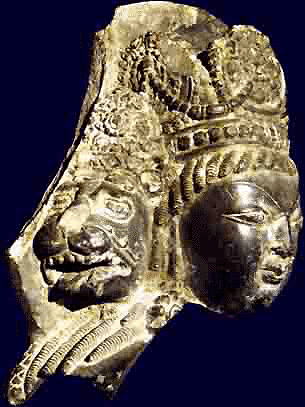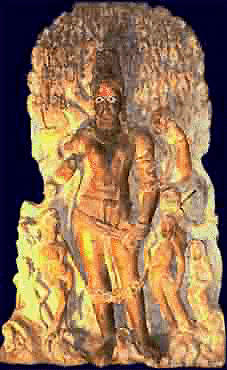
|
|
|
|
BY: SUN STAFF

Vaikukntha Forms of the Lord May 20, 2015 — CANADA (SUN) — A serial presentation of India's great history, religious movements and temple architecture.
The Gurjars
From 550 to 1018 AD, the Gurjars (Gurjaras) played a great part in history of Northern India nearly for 500 years. Present day Rajasthan was under the rule of the Gurjars for centuries. Their capital was situated at Bhilmal (Bhinmal or Srimal), nearly 50 miles to the northwest of Mount Abu.
The Gurjars of Bhilmal conquered Kannuaj on the Ganges at the beginning of 9th Century, then transferred their capital to Kannuaj and founded an empire which, at its peak, was bounded on the east by Bihar, on the west by the lost river, the Hakra, and the Arabian Sea; on the north by the Himalayas and Sutlaj; and on the south by the Jumna and Narmada. [47] The region round Broach, which was an offshoot of this kingdom, was also ruled by the Gurjars of Nandipuri (or Nadol). [48]
Among the spiritual art and architecture attributed to the Gurjaras is their role in the development and proliferation of a Vaikuntha and Visvarupa forms of Lord Visnu. These are particularly associated with the Gurjara-Pratiharas. The history of this temple statuary follows:
During the Kushana period of India's cultural history, there manifested in art and temple iconography a two-dimensional sculpture of Vasudeva, coming out of Balarama's shoulder alongside other motifs. At the back of this sculpture a tree was depicted, the tree, since hoary past, being a theological metaphor which sheltered all the cosmic contemplations of man.
Also found in the Kushana period where six female figures branching out from one another in a singularistic aesthetic form. These images were similar to the tree motif behind the Vasudeva sculptures, a branching dimension from the trunk. The six female figures were an embodiment of Sakti with six gunas. The creative force was thus depicted in a manifestive form vis-à-vis the tree.
Analysing these divine sculptures, Professor Thomas Stuart Maxwell from the University of Bonn, Germany opined that in the Kushana period, the sculptures were sperim-posed to give a dimensional perspective, depicting one body as if coming out from another. In the later period, however, we find only faces and not part of the body coming out from one another. The sculptural remains of the Gupta period, in 5th century AD, testify to this fact.
 In the holy dhama of Mathura, sculptures from this period clearly show that there were two main types of Visnu images. Both were comprised of three-headed, inwardly projections consisting of a crowned Deity in human form with the heads of Lord Varaha and Sri Nrsimhadev (shown at left) emerging out from the junction between neck and shoulder on either side. In the other type of sculpture, one can see the three-headed Visnu with a nimbus behind, studded with numerous miniature figures as described in Bhagavad-gita. This cosmic dimension of Visnu is explained in the Gita as being Visvarupa (see image below), the Lord's cosmic manifestation. In the post-Gupta period, this Visvarupa iconography traveled southward from Mathura along the Dwarka trade-route to Samalji, in northern Gujarat. Simultaneously, the Visvarupa traveled northward into the small mountain-valley kingdoms of western Himalaya, from the Sutlej to the Swat valley. It even traveled up to Kabul, Afghanistan. In Central Asia, the nimbus of Lord Buddha filled with varied motifs were also indicative of thie dimensional manifestation of the Visvarupa potency. In the 8th century, India witnessed the concentration of the two above-mentioned Visnu images, which had been taken up into the hands of two separate power groups. The Visvarupa image was developed and patronised by the Gurjara-Pratiharas as they moved northward from Malwa to the Ganga-Yamuna plain. In the northwest, meanwhile, the three-headed Vaikuntha Visnu was taken up, especially in the Jhelum valley of Kashmir by the later Karokota kings and their successors. This polarisation took a dramatic turn in the 9th century, when the Gurjara-Pratiharas conquered the city of the Kanyakubja (Kannauj), and the Utpala dynasty arose in Kashmir. The Gurjar's developed the iconography of Visvarupa and enshrined at least two major images of this Visnu Deity form in Kannauj itself. On the other hand, Yuvaraja Avantivarman of the Utpalas took up the older icon of three-headed Vishnu and added a fourth face to it. This cautranana-Visnu concept originated from Pancaratrins, whose devotional name was Vaikuntha, and who installed the Deity form in a new temple at Avantipura. This Vaikuntharupa of Visnu consisted of a crowned human face alongside Varaha and Narasimha. At the back of the image, a face is seen which is generally named Kapilamuni, with tripundra tilak and a flat nose resembling an iconographical perspective of Bhairava. It is interesting to note that the faces of Varaha and Narasimha are depicted outward to create a clear angular dimension, and They are unlike the inward or on-looking forty-five degree faces from the Gupta period. Professor Maxwell observed that the face of Varaha is as ferocious as Narasimha Himself, and this was also indicated by Dr. P. Pal and Dr. B.L. Malla in their early scholarly works on the matter. Maxwell traced a Kashmiri legend where it is described that Lord Visnu took on the Varaha depiction in a ferocious manner. Prof. Maxwell.  Pictured at right is the Visvarupa Form at the Ram Laksama temple, Kannauj, Uttar Pradesh, Gurjara-Pratihara period, early 9th c. FOOTNOTES: [47] a b c The Gurjaras of Rajputana and Kannauj, Vincent A. Smith, The Journal of the Royal Asiatic Society of Great Britain and Ireland, (Jan., 1909), pp. 53-75 [48] Ramesh Chandra Majumdar; Achut Dattatrya Pusalker, A. K. Majumdar, Dilip Kumar Ghose, Vishvanath Govind Dighe (1977). The History and Culture of the Indian People: The classical age. Bharatiya Vidya Bhavan. p. 66. [48a] IGNCA lecture series.
| |